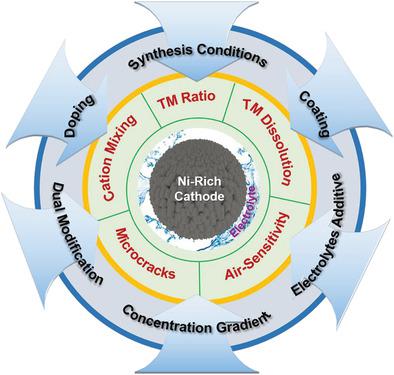当前位置:
X-MOL 学术
›
Adv. Mater. Interfaces
›
论文详情
Our official English website, www.x-mol.net, welcomes your
feedback! (Note: you will need to create a separate account there.)
Surface/Interface Structure Degradation of Ni‐Rich Layered Oxide Cathodes toward Lithium‐Ion Batteries: Fundamental Mechanisms and Remedying Strategies
Advanced Materials Interfaces ( IF 4.3 ) Pub Date : 2019-12-29 , DOI: 10.1002/admi.201901749 Longwei Liang 1 , Wenheng Zhang 1 , Fei Zhao 1 , Dienguila Kionga Denis 1 , Fakhr uz Zaman 1 , Linrui Hou 1 , Changzhou Yuan 1
Advanced Materials Interfaces ( IF 4.3 ) Pub Date : 2019-12-29 , DOI: 10.1002/admi.201901749 Longwei Liang 1 , Wenheng Zhang 1 , Fei Zhao 1 , Dienguila Kionga Denis 1 , Fakhr uz Zaman 1 , Linrui Hou 1 , Changzhou Yuan 1
Affiliation

|
Nickel‐rich layered transition‐metal oxides with high‐capacity and high‐power capabilities are established as the principal cathode candidates for next‐generation lithium‐ion batteries. However, several intractable issues such as the poor thermal stability and rapid capacity fade as well as the air‐sensitivity particularly for the Ni content over 80% have seriously restricted their broadly practical applications. The properties and nature of the stable surface/interface, where the Li+ shuttles back and forth between the cathode and electrolyte, play a significant role in their ultimate lithium‐storage performance and industrial processability. Thus, tremendous efforts are made to in‐depth understanding of the essential origins of surface/interface structure degradation and efficient surface modification methodologies are intensively explored. The purpose of the contribution is first to provide a comprehensive review of the up‐to‐date mechanisms proposed to rationally elucidate the surface/interface behaviors, and then, focus on recent developed strategies to optimize the surface/interface structure and chemistry including synthetic condition regulation, surface doping, surface coating, dual doping‐coating modification, and concentration‐gradient structure as well as electrolyte additives. Finally, the perspective on future research trends and feasible approaches toward advanced Ni‐rich cathodes with stable surface/interface is presented briefly.
中文翻译:

富镍层状氧化物阴极向锂离子电池的表面/界面结构降解:基本机理和修复策略
具有高容量和高功率能力的富镍层状过渡金属氧化物被确定为下一代锂离子电池的主要正极材料。然而,一些棘手的问题,例如差的热稳定性和快速的容量衰减以及空气敏感性,特别是对于镍含量超过80%的空气敏感性,严重限制了其广泛的实际应用。稳定的表面/界面的性质和性质,其中Li +在阴极和电解质之间来回穿梭,在其最终的锂存储性能和工业可加工性中发挥着重要作用。因此,为深入了解表面/界面结构退化的根本原因做出了巨大的努力,并积极探索了有效的表面改性方法。该文稿的目的是首先全面概述为合理阐明表面/界面行为而提出的最新机制,然后着眼于最近开发的优化表面/界面结构和化学性质(包括合成条件)的策略调节,表面掺杂,表面涂层,双重掺杂涂层改性,浓度梯度结构以及电解质添加剂。最后,
更新日期:2019-12-29
中文翻译:

富镍层状氧化物阴极向锂离子电池的表面/界面结构降解:基本机理和修复策略
具有高容量和高功率能力的富镍层状过渡金属氧化物被确定为下一代锂离子电池的主要正极材料。然而,一些棘手的问题,例如差的热稳定性和快速的容量衰减以及空气敏感性,特别是对于镍含量超过80%的空气敏感性,严重限制了其广泛的实际应用。稳定的表面/界面的性质和性质,其中Li +在阴极和电解质之间来回穿梭,在其最终的锂存储性能和工业可加工性中发挥着重要作用。因此,为深入了解表面/界面结构退化的根本原因做出了巨大的努力,并积极探索了有效的表面改性方法。该文稿的目的是首先全面概述为合理阐明表面/界面行为而提出的最新机制,然后着眼于最近开发的优化表面/界面结构和化学性质(包括合成条件)的策略调节,表面掺杂,表面涂层,双重掺杂涂层改性,浓度梯度结构以及电解质添加剂。最后,











































 京公网安备 11010802027423号
京公网安备 11010802027423号